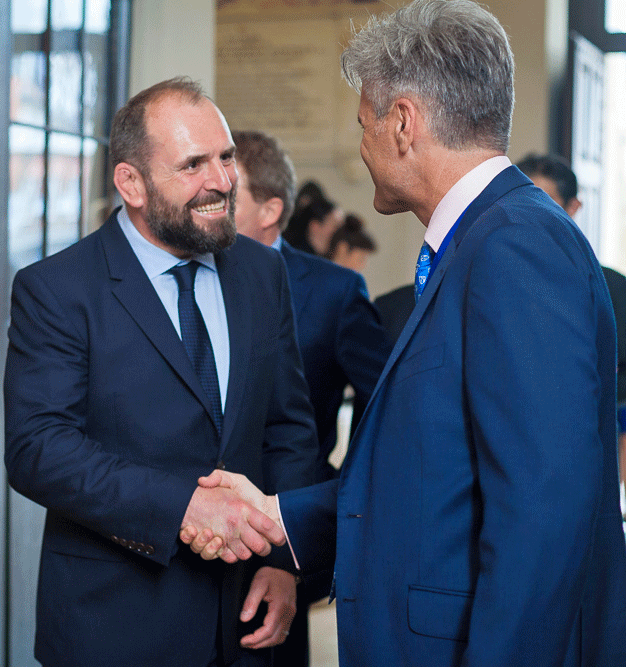Baltic Cape panellist Braemar ACM shares insights
Baltic Briefing discusses broking, market prospects and being a Baltic panellist with Ben Bates, Cape broker at Braemar ACM. The company rejoined the Baltic Capesize Index (BCI) panel in October.
Ben Bates began his broking odyssey in the early 1990s at Rigel Shipping on the handy/supra desk. At the time, there were many experienced brokers in the market who for the previous 30 years had spent mornings working the trading floor of the original Baltic Exchange.
“They had some great stories about life on the old trading floor and certainly gave trainees a sense for the centrality of the Baltic to the world of shipbroking,” says Ben.
Today Ben believes that membership of the Baltic continues to confer trustworthy status on companies and individuals, while being a panellist further enhances companies’ reputations.
“Counterparties are aware that panellist firms must have a comprehensive grasp on what’s going on in the market, and that we are regularly audited by the Baltic itself. At Braemar, we have 12 Cape brokers worldwide and are in continuous contact with each other. As individual brokers we are running calculations all the time and constantly comparing with the BCI type.”
The Baltic Dry Index (BDI) acts as a “general bell-weather” for the market, while more specific indices such as the Baltic Capesize Index (BCI) “stimulate discussion on market values, which is always a good thing”, beyond their FFA settlement and benchmarking role. While decision making is always down to clients, the Baltic indices play a crucial role, enabling brokers to call on reliable information when it comes to advising and informing, Ben asserts.
“We’re encouraged that the signs are more positive than in Q1 2016, however the sheer number of ships – especially modern eco ships in mixed fleets with older vessels – means that the pressure on rates remains.”
Looking ahead, Ben feels that the dry market is heading into a recovery period, however it is currently difficult to see a huge amount of sustainable upside.
“We’re encouraged that the signs are more positive than in Q1 2016, however the sheer number of ships – especially modern eco ships in mixed fleets with older vessels – means that the pressure on rates remains.”
Owners who have invested in new ships are limiting their prospects of seeing meaningful ROI by sustaining older vessels in their fleets.
The future on paper is not dire, but does not reveal a surge in rates, with January FFAs struggling to break free from Q4 rates. However volumes are improved and, according to Ben, “better than had been accounted for.” Having been absent from the Atlantic Cape trade for a few years, Braemar ACM took the decision to resurrect its Atlantic Capes desk in April of this year and has been pleased with the amount of business concluded in the last seven months.
In the same period, Ben says that “a decent amount of index-linked business has been done” on Capes, especially for transatlantic coal routes and period timecharters, demonstrating a reliance amongst owners, brokers and charterers on the Baltic’s numbers. According to Ben, one major mining company uses the Baltic’s C3 Tubarao to Qingdao route assessments “as a line in the sand”.
Commenting on the recent acquisition of the Baltic by Singapore Exchange (SGX), Ben is positive about the potential for development, saying it would be good if the deal attracts new counterparties into the physical market. Regarding the potentially costly effect of new ballast water management and sulphur regulations that have been decided at the International Maritime Organisation (IMO), Ben predicts it will be slow but marked.
Aside from aspiring to a potential return to the Baltic rugby team, Ben will be focusing on leveraging Braemar ACM’s strong relationships with Australian miners and Asian owners and operators as well as the company’s established reputation across all broking sectors, whatever the market may bring.
Braemar ACM also reports on Baltic indices covering Supramax, Handysize, Dirty Tanker, Clean Tanker and LPG routes.
| Ben Bates CV Rigel Shipping 1993 – 2000 |
About the Baltic Exchange Capesize Index
Baltic Exchange Capesize assessments are published Monday – Friday at 11:00.
Baltic Exchange Capesize Index (basis 180000dwt vessel)
| Route | Description | Size (MT) |
| C2 | Tubarao to Rotterdam (long tons) | 160000 |
| C3 | Tubarao to Qingdao | 160000 or 170000 |
| C4 | Richards Bay to Rotterdam | 150000 |
| C5 | West Australia to Qingdao | 160000 or 170000 |
| C7 | Bolivar to Rotterdam | 150000 |
| C15 | Richards Bay to Fangcheng | 160000 |
| C8_14 | Gibraltar/Hamburg transatlantic round voyage | 180000 |
| C9_14 | Continent/Mediterranean trip China-Japan | 180000 |
| C10_14 | China-Japan transpacific round voyage | 180000 |
| C14 | China-Brazil round voyage | 180000 |
| C16 | Revised backhaul | 180000 |
| Weighted Time Charter Average (C8_14, C9_14, C10_14, C14 & C16) |
Baltic Exchange Capesize Index Panel Members
Arrow Chartering (UK) www.arrowship.com
Banchero-Costa www.bancosta.com
Barry Rogliano Salles www.brsbrokers.com
Braemar ACM www.braemaracm.com
Clarksons Platou www.clarksons.com
Fearnleys www.fearnleys.no
EA Gibson Shipbrokers www.gibsons.co.uk
Howe Robinson Partners www.howerobinson.com
Ifchor www.ifchor.com
I & S Shipping www.ildochtrg.co.kr
Leman Shipping Services SA
Simpson Spence Young www.ssyonline.com
Thurlestone Shipping www.thurlestone-shipping.com.sg
Baltic Capesize Index, 1 January 2013 – 13 December 2016

